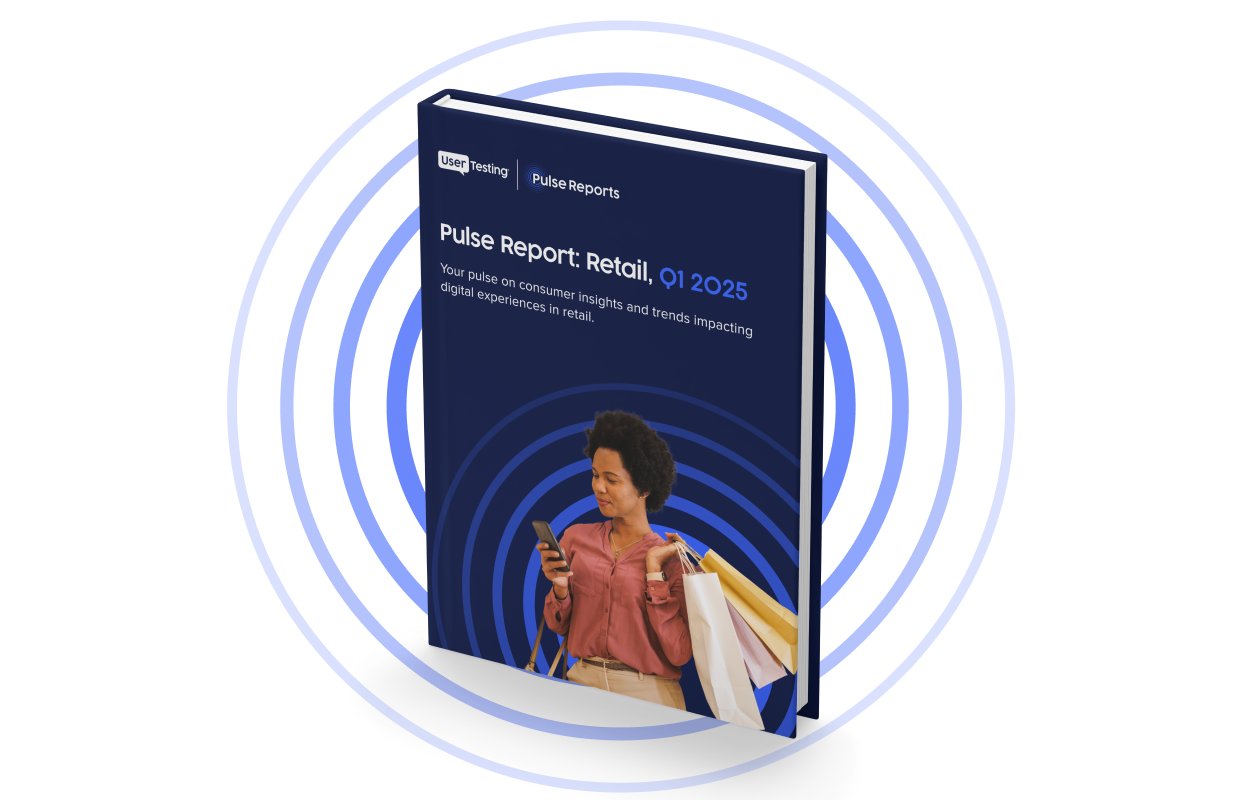
Why world-class retailers rely on more than NPS or CSAT

Retail executives have a lot on their minds. Businesses face multiple challenges, from economic volatility and supply chain disruptions to shifts in consumer behavior and rapid technological advancements. Inflation, rising interest rates, and changing consumer spending patterns are squeezing profit margins. And labor shortages—along with rising wages—challenge retailers to maintain operational efficiency while delivering excellent service.
But consumer expectations show no sign of easing up. Today’s shoppers demand personalized, seamless experiences across online and in-store channels. McKinsey reports that 67% of consumers are willing to spend more on personalized experiences, and 60% will return as a result.
While NPS (Net Promoter Score) and CSAT (Customer Satisfaction Score) provide valuable insights into customer loyalty and satisfaction, when used alone, they often fall short of capturing the full customer experience. These scores fail to answer all the questions.
Customers may recommend a retailer or be satisfied with one experience, but how likely are they to return? Will they ever make another purchase?
Continuous customer listening paired with a holistic experience measurement strategy is at the heart of overcoming these retail challenges and addressing the gaps in traditional metrics. A dedicated culture of customer-centricity integrated into your organization's product development process is essential for fostering innovation, building customer loyalty, and ultimately driving revenue. By consistently gathering and acting on customer feedback, you can stay ahead of the curve and meet evolving customer expectations.
At UserTesting, we see our customers achieving success and gaining customer loyalty through holistic strategies that go beyond traditional retail customer experience metrics like NPS and CSAT to paint a clearer picture of the entire customer journey.
This article will explore real-world examples of the customer listening strategies that get results and illustrate what differentiates retail leaders from the pack despite economic challenges and evolving customer expectations.
We'll explore 3 key types of digital experiences your team can improve with customer feedback:
- Omnichannel experiences
- Mobile experiences
- Conversion rate improvement
By embracing customer-centric strategies, retail executives can future-proof their businesses, turning challenges into opportunities for success.
3 key experiences that require more than NPS
Let’s break down how this overarching strategy translates into specific actions.
1: Omnichannel experiences
Ensuring a seamless and consistent experience across all channels isn’t a differentiator anymore—it’s customers’ expectation. 98% of Americans switch between devices on the same day. Inconsistencies can lead to customer frustration and lost sales. Retail executives must recognize that modern shoppers expect a unified and consistent experience across all touchpoints—whether browsing online, shopping in-store, or engaging through mobile apps and social media.
Omnichannel testing helps to ensure customers can transition effortlessly between channels, enjoying personalized and cohesive interactions at every step. This enhances customer satisfaction and loyalty and provides valuable insights into consumer behavior, enabling retailers to adapt quickly to changing preferences and trends. Research shows that companies with successful omnichannel strategies retain an average of 89% of their customers.
You can meet customer expectations and drive sales by testing experiences with customers to ensure digital experiences are consistent with their online counterparts.
Who’s doing it right: At Michael's, the team streamlined the transition from physical to digital by viewing stores as forward-deployed inventory and showrooms. This approach not only enhanced their online experience but also boosted in-store engagement. Customers could seamlessly move between online and in-store browsing, creating a unified shopping experience.
Learn more here: Watch our webinar, Digital retail innovators: delivering a world-class omnichannel customer experience.
Try it yourself: Understand how customers engage with your brand or products across multiple touchpoints. Watch a demo or check out our Multichannel journey test template.
2: Mobile experience optimization
Optimizing the mobile experience is essential for meeting the evolving needs of consumers. Nearly 60% of website traffic today comes from mobile devices. Consumers expect fast load times, easy navigation, and personalized interactions, which can significantly influence their purchasing decisions and overall satisfaction. Personalized mobile experiences have been seen to boost sales conversion rates by 10-15%.
This makes mobile testing a critical part of any retail product development process. By focusing on mobile experience optimization, retailers can enhance customer engagement, reduce friction in the shopping process, and drive higher conversion rates. Ultimately, investing in mobile optimization is not just about meeting current expectations—it's about future-proofing your business in an increasingly mobile-centric world.
Who’s doing it right: Walmart Canada used UserTesting to combine quantitative and qualitative data, leading to a 13% increase in revenue from mobile purchases. By understanding the specific challenges their customers faced on mobile, they were able to make targeted improvements that boosted satisfaction and sales.
Learn more here: Check out Walmart Canada’s customer story.
Try it yourself: Ensure your mobile site or app is fully responsive, offering a seamless experience across all devices—try our mobile app evaluation test template.
3: Conversion rate improvement
Identifying and reducing barriers to conversion is the first place retailers should start. However, improving conversion rates can often be more complicated than retailers might first expect. While quantitative data may tell part of the story of conversion rate, it isn't always clear why the numbers say what they do.
High abandonment rates could indicate a variety of user experience issues like slow load times, complicated navigation, or lack of trust, while high conversion rates show that your marketing, user experience, and product offerings effectively meet consumer demands. But to really know the why behind the metrics, a customer feedback program is vital. This allows you to hear, firsthand from users, where they're encountering issues or what parts of the experience they like.
Prioritizing conversion rate improvement is not just about boosting sales; it's about creating a customer-centric approach that fosters long-term loyalty and success.
Who’s doing it right: 1-800-PACK-RAT was facing a critical challenge. Their website hadn’t been updated in years, and the organization needed to increase conversion rates to stay competitive. The touchpoint the company wanted to optimize, however, is responsible for over 85% of sales leads. Any updates had to be tested and confirmed to avoid risk to the current pipeline. After incorporating a holistic view of the customer journey, including qualitative and quantitative insights, the company adjusted its strategy, leading to a 10% increase in conversions just 1 week after updating the site.
Learn more here: See how 1-800-PACK-RAT boosted conversions through a combined approach of customer listening and traditional metrics.
Try it yourself: Don’t guess what’s motivating your customers to convert on your website. Try our website conversion template to understand what’s working, what’s not, and how your competition measures up.
Emerging trends and innovations
Although retail leaders can’t predict exactly how markets and customer expectations will change, it’s certain that they will. Taking a holistic approach like the examples shared above, ensures that whatever challenges retailers face, they have a strategy that incorporates continuous customer listening, paired with a suite of quantitative metrics that evaluate the entire customer journey at every touchpoint.
Here are a few examples of emerging technologies and innovations retailers need to keep on their radar.
Artificial intelligence (AI) and machine learning (ML)
AI and ML are revolutionizing retail by providing predictive insights, enhancing personalization, and optimizing inventory management. These technologies are transforming the way retailers operate by automating processes, enhancing decision-making, and delivering personalized customer experiences. AI-driven analytics can predict consumer behavior, optimize inventory management, and streamline supply chains, ensuring that products are available when and where they're needed. Retailers can use AI to analyze vast amounts of data and offer personalized recommendations, improving customer satisfaction and driving sales.
AI can enhance user experience through predictive text, personalized recommendations, and efficient customer service via chatbots. Machine learning algorithms can identify patterns and trends, enabling precise targeting and dynamic pricing strategies.
It is important to remember, overly automated processes may diminish the personal touch that some customers value. Retail executives must balance leveraging AI and machine learning with maintaining human insight to ensure ethical, customer-centric applications that enhance the overall retail experience.
Augmented reality (AR) and virtual reality (VR)
AR and VR are becoming mainstream in retail. AR allows customers to visualize products in their environment via mobile devices, bridging the gap between online and in-store shopping. VR offers immersive experiences, such as virtual store tours, providing a unique way to engage customers. By enabling customers to make more informed purchasing decisions, conversion rates increase. According to Gartner, there was a 90% increase in the conversion rate of AR users in recent years, making it a valuable tool for reducing returns and enhancing the shopping experience.
AR and VR must be strategically used to enhance, not complicate, the user journey. It's another channel that must be successfully and seamlessly integrated into your omnichannel strategy to prevent customer friction. When done successfully, it can create a unique digital experience that compliments traditional shopping methods, enhancing customer satisfaction and driving higher engagement and sales.
The Metaverse
The Metaverse is an emerging virtual space where people can engage and interact. Retailers can create virtual shopping experiences within the Metaverse, allowing customers to explore and purchase products in a virtual store.
Learn more: Learn more about VR and the Metaverse and what your target audience expects for their experience. See what your target audience thinks about your VR/metaverse experience with UserTesting’s metaverse testing.
Smart stores and IoT
Smart stores use IoT sensors and beacons to collect data on customer behavior and preferences. This information can be used to create personalized shopping experiences, optimize inventory management, and improve store layouts. McKinsey reports that self-checkout and marketing personalization through IoT generate significant economic value.
Leveraging these technologies to create harmonious integrations between online and offline experiences will allow customers to effortlessly transition from browsing on their mobile devices to in-store shopping.
Learn more: Find out how to optimize your digital touchpoints and discover your consumers pain points with UserTesting’s IoT testing.
Enhanced payment technologies
Consumers expect minimal barriers during the purchase stage. Having to grab a credit card can cause hesitation due to the extra effort required. Enhanced payment technology can ease this hesitation, especially in today's volatile economy.
Innovations in payment technology, such as digital wallets and "pay by bank" options, are reducing shopping cart abandonment and ensuring a secure and streamlined payment process. Enhanced payment technologies safeguard sensitive information and simplify the checkout process, leading to greater trust, less friction, and higher conversion.
Future-proofing retail businesses
Retailers face an interesting time in history. The cost of not adapting to rising customer standards is steep: decreased customer loyalty, missed revenue opportunities, and operational inefficiencies. The strategies discussed here are about more than staying competitive—they can help organizations be prepared for the future.
UserTesting’s QXscore consolidates user attitudes and behaviors into a single metric, providing a broader perspective that NPS and CSAT might overlook. This holistic approach allows retailers to identify nuanced areas of improvement and better understand the complete customer journey. QXscore can play a key part in pinpointing where customers experience friction in their journey and prioritizing which experiences to work on.
Embracing UserTesting’s advanced customer feedback capabilities—and consultative approach with professional services—can help you transform your digital customer experiences.
By leveraging the insights and strategies outlined here, you can drive significant improvements in your retail operations, enhance customer satisfaction, and secure a stronger market position.

Pulse Report: Retail, Q1 2025
Uncover the drivers behind consumer loyalty and how innovative retailers succeed in this quarterly Pulse Report.





